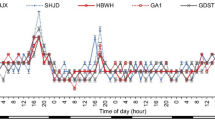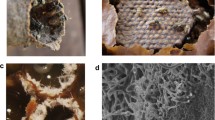Abstract
Costelytra zealandica (Coleoptera: Scarabeidae) is a univoltine endemic species that has colonised and become a major pest of introduced clover and ryegrass pastures that form about half of the land area of New Zealand. Female beetles were previously shown to use phenol as their sex pheromone produced by symbiotic bacteria in the accessory or colleterial gland. In this study, production of phenol was confirmed from the female beetles, while bacteria were isolated from the gland and tested for attractiveness towards grass grub males in traps in the field. The phenol-producing bacterial taxon was identified by partial sequencing of the 16SrRNA gene, as Morganella morganii. We then tested the hypothesis that the phenol sex pheromone is biosynthesized from the amino acid tyrosine by the bacteria. This was shown to be correct, by addition of isotopically labelled tyrosine (13C) to the bacterial broth, followed by detection of the labelled phenol by SPME-GCMS. Elucidation of this pathway provides specific evidence how the phenol is produced as an insect sex pheromone by a mutualistic bacteria.



Similar content being viewed by others
References
Brucker RM, Bordenstein SR (2012) Speciation by symbiosis. Trends Ecol Evol 27(8):443–451. doi:10.1016/j.tree.2012.03.011
Dillon R, Charnley K (2002) Mutualism between the desert locust Schistocerca Gregaria and its gut microbiota. Res Microbiol 153(8):503–509
Dillon RJ, Vennard CT, et al. (2002) A note: gut bacteria produce components of a locust cohesion pheromone. J Appl Microbiol 92(4):759–763. doi:10.1046/j.1365-2672.2002.01581.x
East R, Henzell R, et al. (1982) An evaluation of sex attractant traps for monitoring grass grub, Costelytra zealandica, populations (Coleoptera: Scarabaeidae). N Z Entomol 7(3):262–265
El-Sayed AM (2016). Database of pheromones and semiochemicals www.pherobase.com. Accessed 2 Mar 2016
Fenemore PG, Read PE, et al. (1972) Studies of the phenolic resin Durez 12687 as an attractant for adults of Costelytra zealandica. N Z J Agric Res 15:376–387. doi:10.1080/00288233.1972.10421266
Given BB, Hoy JM (1952) A revision of the Melolonthinae of New Zealand. N Z Dep Sci Ind Res Bull 102:1–137
Henzell RF, Kain WM (1972) Field trials with phenol for grass grub control. Proc N Z Weed Pest Control Conf 25:263–271
Henzell RF, Lowe MD (1970) Sex attractant of the grass grub beetle. Science 168:1005–1006. doi:10.1126/science.168.3934.1005
Hoyt CP, Osborne GO, et al. (1971) Production of an insect sex attractant by symbiotic bacteria. Nature (London) 230:472–473. doi:10.1038/230472a0
Leal WS (1997) Evolution of sex pheromone communication in plant-feeding scarab beetles. Insect Pheromone Res:505–513
Leal WS (1998) Chemical ecology of phytophagous scarab beetles. Annu Rev Entomol 43:39–61. doi:10.1146/annurev.ento.43.1.39
Leufven A, Bergstrom G, et al. (1984) Interconversion of verbenols and verbenone by identified yeasts isolated from the spruce bark beetle Ips typographus. J Chem Ecol 10(9):1349–1361. doi:10.1007/Bf00988116
McDermott C, Mylotte JM (1984) Morganella morganii: epidemiology of bacteremic disease. Infect Control 5(3):131–137
Nagasawa T, Utagawa T, et al. (1981) Syntheses of L-tyrosine-related amino acids by tyrosine phenol-ly ase of Citrobacter intermedius. Eur J Biochem 117:33–40
O’Hara CM, Brenner FW, et al. (2000) Classification, identification, and clinical significance of Proteus, Providencia, and Morganella. Clin Microbiol Rev 13(4):534–546
Osborne GO, Hoyt CP (1969) A chemical attractant for males of the grass grub beetle Costelytra zealandica (white) (Col., Scarabaeidae). Bull Entomol Res 59:81–83. doi:10.1017/s0007485300003047
Ruther J, Reinecke A, et al. (2001) Make love not war: a common arthropod defence compound as sex pheromone in the forest cockchafer Melolontha hippocastani. Oecologia 128(1):44–47. doi:10.1007/s004420100634
Ruther J, Reinecke A, et al. (2002) Phenol—another cockchafer attractant shared by Melolontha hippocastani Fabr. and M-melolontha L. Z Naturforsch C 57(9–10):910–913
Stringer IAN (1988) The female reproductive-system of Costelytra zealandica (white) (Coleoptera, Scarabaeidae, Melolonthinae). N Z J Zool 15(4):513–533
Unelius CR, Townsend RJ, et al. (2008) Comparisons of traps and lures for monitoring grass grub, Costelytra zealandica. N Z Plant Protect 61:215–221
Updegraff DM (1949) The production of phenol and p-cresol by means of bacteria. J Bacteriol 57:555–564
Zarbin PHG, Leal WS, et al. (2007) Identification of the sex pheromone of Phyllophaga cuyabana (Coleoptera: Melolonthidae). Tetrahedron Lett 48(11):1991–1992. doi:10.1016/j.tetlet.2007.01.075
Acknowledgments
This research was funded by the Ministry of Building Innovation and Employment through the Bio-Protection Research Centre (LINX0304, contract 25949). The Linnaeus University, Kalmar, Sweden, is gratefully acknowledged for financial support of C.R. Unelius.
Author information
Authors and Affiliations
Corresponding author
Additional information
Communicated by: Sven Thatje
Rights and permissions
About this article
Cite this article
Marshall, D.G., Jackson, T.A., Unelius, C.R. et al. Morganella morganii bacteria produces phenol as the sex pheromone of the New Zealand grass grub from tyrosine in the colleterial gland. Sci Nat 103, 59 (2016). https://doi.org/10.1007/s00114-016-1380-1
Received:
Revised:
Accepted:
Published:
DOI: https://doi.org/10.1007/s00114-016-1380-1




